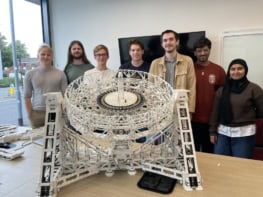The Canadian teenager Maryam Tsegaye has bagged a total of $400,000 in prizes for making the above video about quantum tunnelling. Tsegaye, 17, is winner of the 2020 Breakthrough Junior Challenge, which was founded by the billionaires Yuri and Julia Milner. Tsegaye is a student at École McTavish Public High School in Fort MacMurray and her teacher Katherine Vladicka-Davies will get $50,000 of that prize money. The school will get $100,000 for a new science lab and the remaining $250,000 goes to Tsegaye as a college scholarship.
“Maryam’s video is a prime example of how to cleverly simplify a complex idea, and she provided a remarkable explanation of quantum tunnelling,” says Scott Kelly, a retired NASA astronaut who was a prize judge.
Tsegaye says the win is a “life-changing moment for me, and presents so many new opportunities that nothing will be the same from now on”.
Enough left in the tank
What is the ideal strategy to win a short-distance horse race – start off slow to conserve energy or go out hard and hope you have enough left in the tank for a final kick? Mathematicians Quentin Mercier and Amandine Aftalion at the School for Advanced Studies in the Social Sciences (EHESS) in Paris have now attempted to answer that question by analysing the mathematics behind thoroughbred horseracing.
They used a GPS tracking tool placed under the jockey’s saddles at the Chantilly racetracks north of Paris to create a model of winning strategies at three different lengths on a looped track: 1300 m, 1900 m and 2100 m. The model even considered the aerobic and anaerobic energy of the horses as well as the slope and bend of the track. Rather than holding the horses back for a strong finish, the researchers found that a strong start is a better strategy but keeping just in enough in reserve to provide a final kick to the finish line.
“Information on a horse speed, endurance or running economy coupled with simulations can help to predict how a horse profile is adapted to some distances to run,” the authors write, adding that “to maximize an individual horse’s potential for winning, it should be entered in races appropriate for its racing ability”.
Their paper in PLOS One is called “Optimal speed in Thoroughbred horse racing”.



